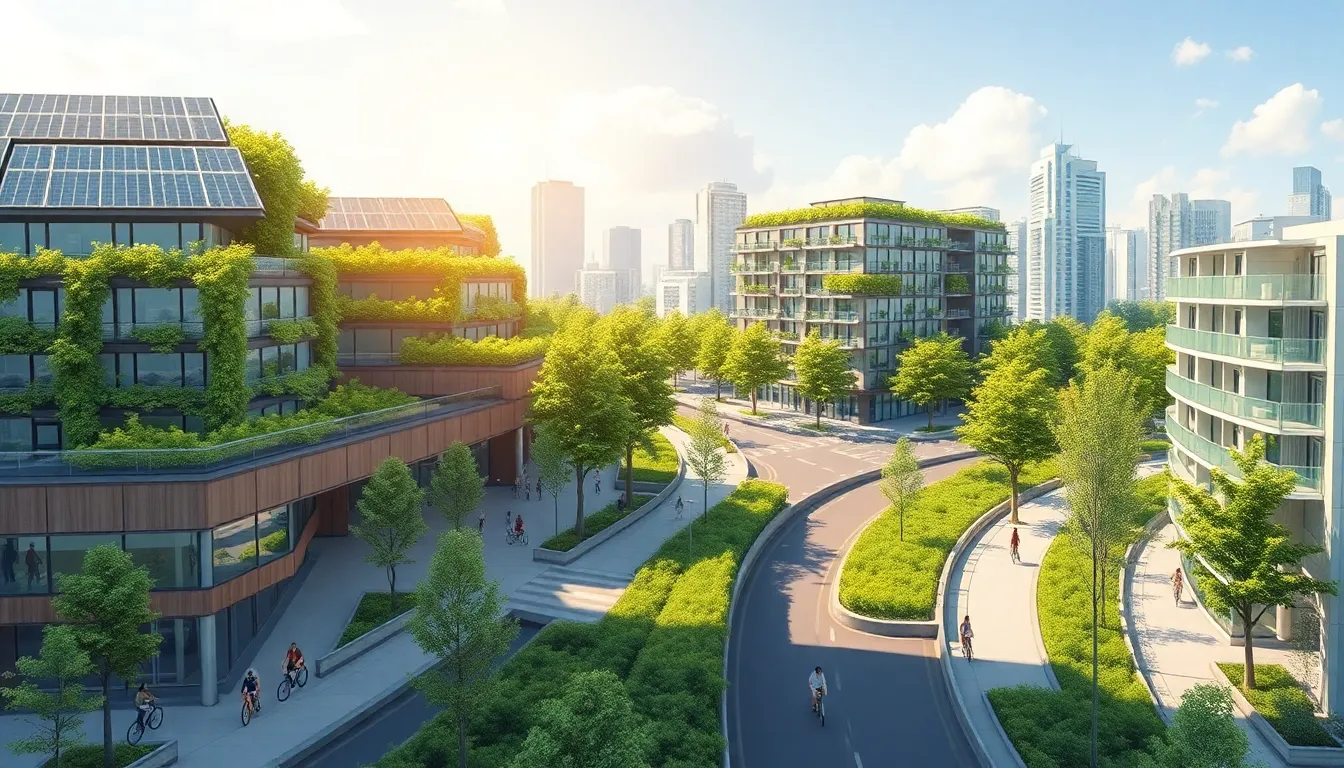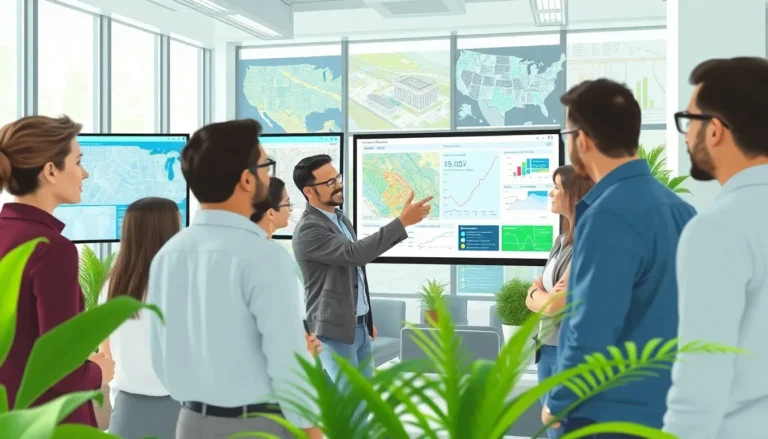Table of Contents
ToggleIn a world where Mother Nature occasionally throws tantrums and cities face challenges like traffic jams and rising sea levels, urban resilience technology is stepping up to the plate. Think of it as the superhero of smart cities, equipped with gadgets and gizmos designed to keep urban life thriving, even when chaos reigns.
From sensors that monitor air quality to smart grids that make energy use as efficient as a well-oiled machine, these innovations are more than just techy toys. They’re vital tools that help cities adapt, survive, and even flourish in the face of adversity. So, buckle up as we dive into the exciting world of urban resilience technology, where innovation meets necessity, and the future of city living is looking brighter than ever.
Overview of Urban Resilience Technology
Urban resilience technology encompasses a range of tools and systems designed to enhance the adaptability of cities. Data-driven solutions play a critical role in monitoring urban environments. Technologies such as air quality sensors, which detect pollution levels, enable real-time responses to health risks, ensuring community safety.
Smart grids also contribute substantially to urban resilience. They optimize energy distribution, reduce outages, and improve efficiency. Implementing these systems allows cities to maintain functionality during extreme weather events or other disruptions.
Moreover, predictive analytics helps cities forecast challenges before they arise. By analyzing trends related to climate change and population growth, urban planners can implement proactive measures. Examples include flood-resistant infrastructure and adaptive green spaces, which bolster a city’s defense against inevitable threats.
Emergency management applications further enhance urban resilience. These tools streamline communication during crises, ensuring that citizens receive timely information. Coordinated response systems improve overall effectiveness when dealing with natural disasters or public health emergencies.
Innovative technologies like augmented reality assist in visualizing potential urban developments. This insight aids planners and stakeholders in understanding the impact of changes in real-time. Engaging the community in discussions surrounding urban resilience fosters collaboration and informed decision-making.
Ultimately, urban resilience technology provides cities the means to not just respond to challenges but thrive in the face of them. Continuous advancements in this field promise smarter solutions for sustainable urban living.
Key Components of Urban Resilience Technology

Urban resilience technology comprises essential components that enhance city adaptability to challenges. Two critical categories include infrastructure and urban design, along with data-driven solutions.
Infrastructure and Urban Design
Innovative infrastructure forms the backbone of urban resilience. Green buildings effectively reduce environmental impacts while enhancing energy efficiency. Sustainable transportation systems promote the use of public transit and cycling, easing congestion and lowering emissions. Stormwater management strategies address flooding risks by utilizing permeable surfaces and retention basins. Urban green spaces offer multiple benefits, including improved air quality and community well-being. These design principles increase a city’s ability to withstand and recover from adverse events.
Data-Driven Solutions
Data-driven solutions play a vital role in enhancing urban resilience. Real-time air quality sensors help detect pollution levels and notify citizens of health risks promptly. Predictive analytics empower planners to foresee challenges linked to climate change and urbanization. Smart grid technology optimizes energy distribution, ensuring continuous power during outages. Analyzing traffic patterns aids in reducing congestion, fostering efficient mobility. Emergency management applications facilitate communication and resource allocation during disasters. These solutions create a data-informed approach to urban resilience, enabling proactive decision-making and community engagement.
Benefits of Urban Resilience Technology
Urban resilience technology offers numerous benefits that enhance city living and security. Key advantages range from environmental sustainability to economic growth.
Environmental Sustainability
Promoting environmental sustainability remains a central focus of urban resilience technology. This technology aids cities in reducing carbon footprints through innovative infrastructure. Green buildings utilize energy-efficient materials and renewable energy sources, decreasing resource consumption. Sustainable transportation systems, including electric public transit and bike-sharing programs, lower emissions and encourage eco-friendly commuting. Water management strategies improve stormwater control, reducing flooding risks while protecting natural ecosystems. Urban green spaces, like parks and community gardens, not only enhance air quality but also foster biodiversity. These efforts contribute significantly to the overall health of urban environments, creating cities that adapt better to climate challenges.
Economic Growth
Facilitating economic growth forms another critical benefit of urban resilience technology. Businesses thrive in environments equipped with smart solutions that streamline water, energy, and waste management. Efficient smart grids optimize energy usage, reducing costs for consumers and enterprises alike. By enhancing mobility through optimized traffic patterns, cities attract new businesses while improving local commerce. Data analytics empower governments to make informed investment decisions, targeting areas that need infrastructure upgrades. The integration of technology leads to job creation in various sectors, including tech, engineering, and sustainability. Ultimately, resilient urban environments lay the groundwork for enduring economic stability and growth.
Challenges in Implementing Urban Resilience Technology
Implementing urban resilience technology faces several important challenges. Financial limitations often restrict cities from fully integrating these advanced systems. Budget constraints may result in prioritization issues, leading to incomplete projects and minimal impact.
Financial Constraints
Funding urban resilience initiatives often proves difficult, especially in economically strained areas. Cities may lack access to necessary resources, which hampers technology adoption. Investment in infrastructure improvements comes with significant costs, making it hard for local governments to allocate adequate budgets. Public-private partnerships can mitigate some financial challenges, yet securing cooperation often takes time. Limited availability of grants or financial incentives also impacts the pace of adopting resilience technologies.
Public Awareness and Education
Public awareness remains another significant obstacle to implementing urban resilience technology. Many community members may not understand the benefits of these innovations. Education initiatives are essential to foster support and engagement, ensuring that citizens recognize the value of resilience technologies. Information campaigns can effectively raise awareness about issues like climate change and urban sustainability. Engaging stakeholders during the planning stages helps cultivate a sense of ownership and responsibility for urban resilience. Promoting understanding and involvement within communities ultimately drives the successful implementation of technology solutions.
Case Studies of Successful Urban Resilience Technology
Cities around the world showcase effective urban resilience technology in action. Barcelona, Spain, exemplifies innovative uses of data-driven solutions. The city implemented a smart waste management system that utilizes sensors to optimize collection routes. This initiative reduces operational costs and minimizes environmental impact.
In the U.S., New York City adopted real-time air quality monitoring. Data from over 300 sensors help identify pollution hotspots, enabling quick responses to health risks. Affected populations receive timely alerts through a dedicated mobile application, fostering a more informed community.
Singapore stands out with its integrated stormwater management system. The city employs smart drains that automatically adjust to rainfall levels. This technology significantly alleviates flooding and protects public health by managing water levels efficiently.
London’s smart traffic management system employs predictive analytics for congestion reduction. Cameras and sensors collect data to manage traffic flow dynamically. The result is improved mobility and reduced emissions, contributing to a cleaner urban environment.
A notable example is the resilience-building efforts in Norfolk, Virginia. The city integrates green infrastructure into its urban design, including rain gardens and permeable pavements. These efforts enhance stormwater absorption, reduce flooding risks, and create attractive public spaces.
Lastly, Tokyo utilizes a comprehensive earthquake early warning system. This technology alerts citizens seconds before seismic events occur, providing crucial time for protective actions. The city’s proactive approach has increased survival rates and reduced damage to infrastructure during disasters.
The effectiveness of these urban resilience technologies illustrates their potential to transform cities. Each case emphasizes that innovation can lead to safer, more sustainable urban environments.
Urban resilience technology stands as a beacon of hope for cities grappling with modern challenges. By integrating innovative solutions and sustainable practices, cities can enhance their adaptability and overall quality of life. The success stories from various global cities demonstrate that these technologies not only mitigate risks but also foster economic growth and environmental sustainability.
As urban areas continue to evolve, embracing these advancements will be crucial. Public engagement and education will play a vital role in ensuring that communities recognize the importance of these technologies. With commitment and collaboration, urban resilience technology can pave the way for a brighter and more sustainable future for cities worldwide.







